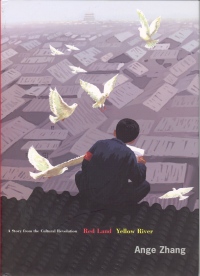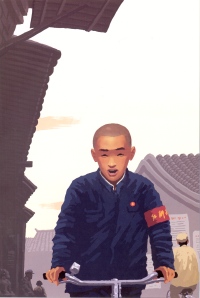| ________________
CM . . .
. Volume XI Number 15 . . . .April 1, 2005
excerpt:
In this autobiographical account of his youth, Ange Zhang describes his experiences during the Cultural Revolution in China through an economy of words and powerful illustrations and photographs. Young readers will not only get a concise history of that era in China but also an evocative description of what is was like to suffer social upheaval and the destruction of a happy family life. Beginning in 1966, Chairman Mao's Red Guards purged the country of intellectuals and property owners and destroyed cultural artifacts and books in an effort to replace old customs and thinking with new "reformed" ideas. Ange's father, although a former high ranking official in the Communist Party, was humiliated publicly as a counter-revolutionary. A famous writer, he composed the words for the "Yellow River Cantata" sung by Chinese people all over the world hence the title. His antique Ming vases and paintings were destroyed and his books locked up. His family was ostracized, and Ange became a "black kid" and experienced anger and shame. Skilled at drawing and calligraphy, Ange was asked to make posters for the Red Guards but was not invited to join. Distressed at being an outsider and longing to be a member of the Red Guard, he set up his own Red Guard group and joined the revolution.
In 1968, 15-year-old Ange is sent along with other students to the countryside to be educated as farmers. Despite the deprivation and backbreaking work on the collective farm, he finds joy in the smuggled books he reads at night. Using oil paints given to him by a friend, Ange rediscovers his talent as an artist and rekindles his hope. An epilogue describes how Ange made his way back to Beijing to study at the Central Academy of Drama. He eventually became the set designer for the Chinese National Opera Theatre. Later during the Tiananmen uprising, Ange, as a visiting set designer in Stratford, Ontario, was offered asylum by the Canadian government. The last section in the book is a very readable and succinct history of the Cultural Revolution in China, which helps to explain the context for the young reader. The bold, angular illustrations, which echo the propaganda posters Ange once made for the Red Guard, are produced with "digital paint" using graphics software. It is the same software that Zhang now uses to animate the TV cartoon about a teenage girl, Braceface for Nelvana. Photographs of the period, including some of his family, help the reader to identify with Ange. Ange Zhang has illustrated a number of books by Teddy Jam including the recent The Kid Line as well as The Stone Boat and Thor by W.D. Valgardson For further reading on this subject from a girl's point of view, try Red Scarf Girl: A Memoir of the Cultural Revolution by Ji-li Jiang. Highly Recommended. Jane Bridle is a Youth Services Librarian at the Winnipeg Public Library in Winnipeg, MB.
To comment
on this title or this review, send mail to cm@umanitoba.ca.
Copyright © the Manitoba Library Association. Reproduction for personal
use is permitted only if this copyright notice is maintained. Any
other reproduction is prohibited without permission.
NEXT REVIEW |
TABLE OF CONTENTS FOR THIS ISSUE
- April 1, 2005.
AUTHORS |
TITLES |
MEDIA REVIEWS |
PROFILES |
BACK ISSUES |
SEARCH |
CMARCHIVE |
HOME |

 Ange describes the dissolution of the ancient Chinese society and the decline of any art that is not revolutionary in nature. With schools closed and with nothing to do, he discovered the books in his father's study. Over the following months, he read banned books by Victor Hugo, Charles Dickens and Leo Tolstoy that transported him from the confusing world. (It is interesting to note that these classic authors are now among the few Western titles available for purchase in English in China. It is also remarkable that this book was printed and bound in China.)
Ange describes the dissolution of the ancient Chinese society and the decline of any art that is not revolutionary in nature. With schools closed and with nothing to do, he discovered the books in his father's study. Over the following months, he read banned books by Victor Hugo, Charles Dickens and Leo Tolstoy that transported him from the confusing world. (It is interesting to note that these classic authors are now among the few Western titles available for purchase in English in China. It is also remarkable that this book was printed and bound in China.)